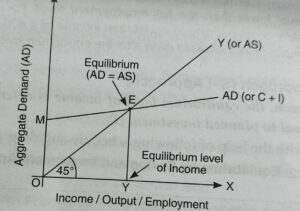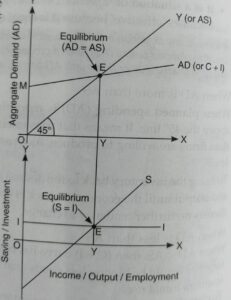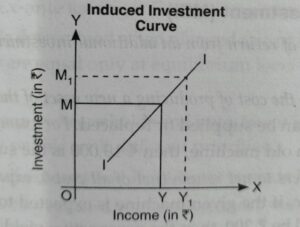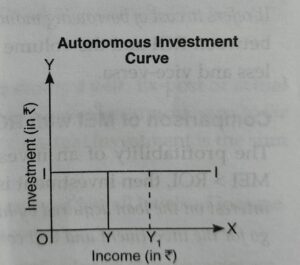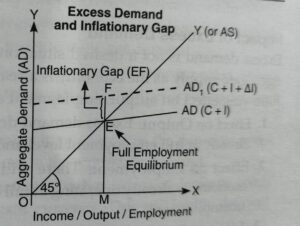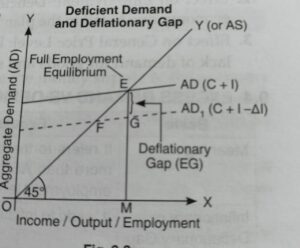Macro Economics part 5
In Macro Economics Part 5 we will learn about aggregate demand and aggregate supply an it’s basic concept and its effects in National Income of macro economics

Aggregate Demand In Macro Economics part5 is the total demand for final goods and services in an economy during an accounting year.
Aggregate demand is aggregate expenditure on ex-ante (planned) consumption and ex-ante (planned) investment that all sectors of the economy are willing to incur at each income level.
In terms of Keynes, aggregate demand is the total amount of money, which the buyers are ready to spend on purchase of goods and services, produced in an economy during a given period.
It should be kept in mind that Keynes measured aggregate demand not in terms of physical goods and services but as a part of total income that society is ready to spend.
Components of aggregate demand in Macro Economics part5
(i) Private (or Household) consumption demand. The total expenditure incurred by all the households of the country on their personal consumption is known as private consumption expenditure.
Consumption demand depends mainly on disposable income and propensity to consume.
(ii) Private investment demand is the demand for capital goods by private investors. It is addition to the existing stock of real capital assets such as machines, tools, factory – building etc.
Investments demand depends upon marginal efficiency of capital (Marginal efficiency of investment) and interest rate.
Investment is of two types,
Autonomous Investment and Induced investment, but in Keynes theory investment is assumed to be Autonomous.
The basic difference between Induced Investment and Autonomous Investment
(iii) Government demand for goods and services Its curve is upward sloping rises up to Right.
In a modern economy, the government is an important buyer of goods and services.
It is income inelastic, i.e., it is not affected by change in income level. The volume of autonomous investment is the same at all levels of income.
Its curve is a straight line parallel to horizontal axis.
The government demand may be on account of public needs for roads, schools, hospitals, power, irrigation etc, for the maintenance of law and order and for defense.
(iv) Demand for net export (X – M)
Net export represents foreign demand for goods and services produced by an economy.
When exports exceed imports, net exports is positive and when imports exceed, net exports is negative.
Exports and imports of a country are influenced by a number of factors such as foreign trade policy, exchange- rate, prices and quality of goods etc.
Thus, aggregate demand consists of these four types of demand.
However, for the sake of simplicity Keynes included only two types of demand,
Consumption demand (C) Investment demand (I)
Aggregate demand can be explained with the help of AD schedule and AD curve. AD= C + I
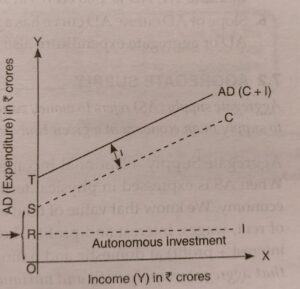
Income(Y) Consumption (C) Investment (I) AD=C+I
0 40 20 60
100 120 20 140
200 200 20 220
300 280 20 300
400 360 20 380
500 440 20 460
600 520 20 540
2. Aggregate Supply in Macro Economics pat5
The concept of aggregate supply (ΔS) is related with the total supply of goods and services by all the producers in an economy.
Four factor of production like land, labour, capital and enterprise are required for the production of goods and services.
Producers pay rent to land, wages and salaries to labour, interest to capital and Profits to the entrepreneur for their services in production.
This payment is factor- cost from producer’s point of view and factor-income from factor-owner angle.
Aggregate supply is the total amount of money value of goods and services, (which is paid to the factor of production against their factor services) that all the producers are willing to supply in an economy.
In other words, it is the total cost of production of goods and services produced in a country or it is the value of net national product at factor cost (NNPFC).
Thus, the main components of aggregate supply are: i) National Income Y ii) Consumption C iii) Saving S
National Income = Consumption + Saving==> Y=C+S
Saving (S) Consumption (C) Saving (S) AS=C+S
0 40 -40 0
100 120 -20 100
200 200 0 200
300 280 20 300
400 360 40 400
500 440 60 500
Consumption function in Macro Economics Part 5 expresses functional relationship between aggregate consumption and national income.
Thus, consumption (C) is a function of income (Y). C = F (Y)
Where, C = Consumption; F = Function; Y = Disposable income Consumption at a point of time can be measured with the equation:
C=ƒ(Y) C= Consumption , Y= National Income F= functional relationship
According to Keynes, as income increases consumption expenditure also increases but increase in consumption is smaller than the increase in income.
In other words, consumption lags behind income. This is called Keynes’ Psychological law of Consumption. According to Keynes, propensity to consume of the people remains stable in the short period.
Break-even point in Macro Economics Part5 is the point in the level of income at which consumption is just equal to income. In other words, whole of income is spent on consumption and there is no saving. Below this level of income, consumption is greater than income but above this level, income is greater than consumption.
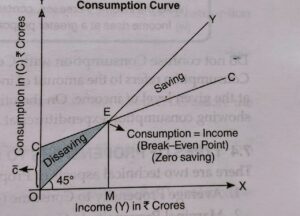
Income(I) Consumption (C)
0 40 dissaving
100 120 ”
200 200 break even point
300 280 saving
400 360 ”
500 440 ”
In the given imaginary household schedule of consumption and saving, at annual income level of Rs.200 consumption is Rs.200 and in consequence there is no saving. This is break-even point.
It is evident from the table and diagram that:2
As the income increases, consumption also increases, but the increase in consumption remains less than the increase in income.
Income can be zero but consumption can never be zero in the economy.
When C > Y, saving are negative.
When C = Y, savings are zero. This is known as break-even point. This is shown by point E in the diagram. Thus break-even point indicates a point where consumption becomes equal to income or consumption curve cuts the income curve.
Propensity to consume in Macro Economics Part5
a)Average propensity to consume (APC)
The ratio of aggregate consumption expenditure to aggregate income is known , as average propensity to consume. It indicates the percentage (or ratio) of income which is being spent on consumption.
It is worked out by dividing total consumption expenditure (C) by total income (Y). Average Propensity to Consume (APC) APC= aggregate Consumption ÷ total Income
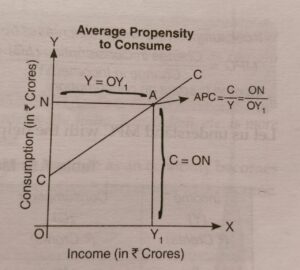
It can be explained with the help of following schedule and diagram:
Income (Y) Consumption (C) APC= C÷I
0 40 —
100 120 120÷ 100= 1.20
200 200 200÷200= 1
300 280 280÷300 = .933
Important Points for APC:
When APC is more than 1: When APC is more than 1, consumption is more than national income, i.e. before the break-even point.
APC = 1: When APC is equal to 1, consumption is equal to national income, which is known as to be break-even point.
When APC is less than 1: When consumption is less than national income, i.e. beyond the break-even point.
(b) Marginal Propensity to consume (MPC) in Macro Economics Part 5
The ratio of change in consumption (C) to change in income (Y) is known as marginal propensity to consume. It indicates the proportion of additional income that is being spent on consumption.
MPC= Change in Consumption÷ Change in Income
MPC= ΔC÷ΔY
It can be explained with the help of following schedule and diagram:
Income (Y) Consumption (C) ΔC ΔY MPC= ΔC÷ΔY
0 40 – – –
100 120 80 100 80/100= .8
200 200 80 100 80/100=.8
300 280 80 100 80/100=.8
Important points for MPC:
Value of MPC varies between 0 and 1: As we know that increase in income is either spent on consumption or saved for future use.
MPC falls with the successive increase in income: It happens because as an economy becomes richer, it has the tendency to consume smaller percentage of each increment to its income.
Propensity to save Macro Economics Part5 (or saving function)shows the functional relationship between aggregate savings and income.
S= ƒ(Y) S= Saving Y= National Income ƒ= Function relation
It is evident from the saving-function schedule and diagram that as income increases saving also increases.
Saving can be both negative and positive. Prior to break-even point saving is negative, at break-even point saving is zero and after the break-even point saving is positive.
Income (Y) Consumption (C) Saving (S=Y-C)
0 40 -40 dissaving
100 120 -20 ”
200 200 0 break even point
300 280 20 saving
400 360 40 ”
500 440 60 ”
600 520 80 ”
Important points for Saving function: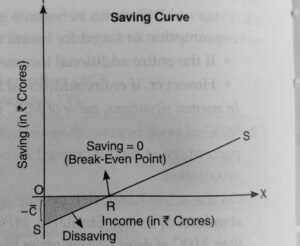
Starting Point of Saving Curve: Saving curve (SS) starts from point starts on the Y-axis, indicating that there is negative saving. (equal to amount of autonomous consumption) when national income is zero.
The saving curve will have a negative intercept on Y-axis of the same magnitude as the consumption curve has positive intercept on the Y-axis.
It happens because if consumption is positive at zero level of income, then there would be dis-savings of the same magnitude.
Break-even point .(S = 0)
Saving curve crosses the X-axis at point R which is known as break-even point as at this point saving is zero (or consumption is equal to income).
Positive Saving: After the break-even point saving is positive.
Types of propensity to save
Average propensity to save (APS): The ratio of aggregate saving to aggregate income is known as average propensity to save (APS). By dividing aggregate saving by aggregate income, we get APS.
APS= Saving (S)÷Income (Y)
Income (Y) Saving (S) APS= S/I
o -40 —
100 -20 -20/100= -.2
200 0 0/100 =0
300 20 20/300 = .067
400 40 40/400 = .1
Important Points for APS:
APS can never be 1 or more than one. As saving can never be equal to or more than national income.
APS can be 0: APS is 0 when income is equal to consumption i.e., saving = 0. This point is known as break-even point.
APS can be negative or less than 1.
At income levels which are lower than the break-even point APS can be negative as there will be dis-savings in the economy.
APS rises with increase in income. APS rises with the increase in income because the proportion of income saved keeps on increasing.
Marginal Propensity to Save :It is the ratio of change in saving (ΔS) to change in income (ΔY) is called MPS. It is proportion of income saved out of additional (incremental) income.
MPS = Change in saving ÷ Change in Income
Income(Y) Saving(S) ΔS ΔY MPS= ΔS/ΔY
It is to be noted MPS lies between 0 to 1 when ΔC=0 than MPS=1
RELATION BETWEEN APC &APS
We know that National Income is the sum of Consumption and saving Y= C+S ——– (1)
divide Income (Y) to the equation (1)
Y/Y = C/Y+S/Y
1 = C/Y + S/Y since APC= C/Y APS= S/Y
1 = APC +APS
